Lacertids (Lacertidae)
The slender body, well-developed limbs and long tail of most species are indicative of the superior sprinting abilities of lacertids. They are very active and all are diurnal. Lacertids are mainly ground-living, although rock-living and arboreal forms are also found. There are no burrowing species and limb reduction is rare and restricted to grass-living species. With the exception of one species, all are egg-laying. Twenty six species occur in South Africa.
Lacertids are small or medium-sized lizards. Most species are less than 9 cm long, excluding the tail. They are primarily insectivorous. An exception is Meroles anchietae, one of the few wall lizards that regularly eats seeds – an appropriate food for a lizard of the harsh Namib Desert.
Lacertids are remarkably similar in form, with slender bodies and long tails, but have highly varied patterns and colours, even within the same species. Their scales are large on the head, which often also has osteoderms, small and granular on the back, and rectangular on the underside. Most species are sexually dimorphic, with the males and females having different patterns.
Africa Wild Reptile Book: Lizards - Photos & Descriptions
Moderator: Klipspringer
Africa Wild Reptile Book: Lizards - Photos & Descriptions
Bushveld Lizard Heliobolus lugubris (Bosveldakkedis)
Family: Lacertidae
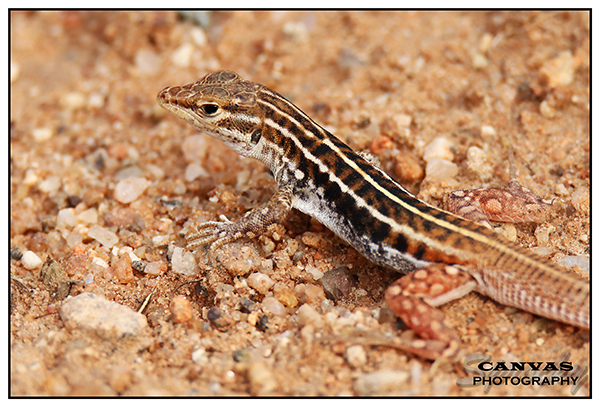 © Sprocky
© Sprocky
Grietjie Private Reserve, Limpopo
 © Klipspringer
© Klipspringer
Hatchling
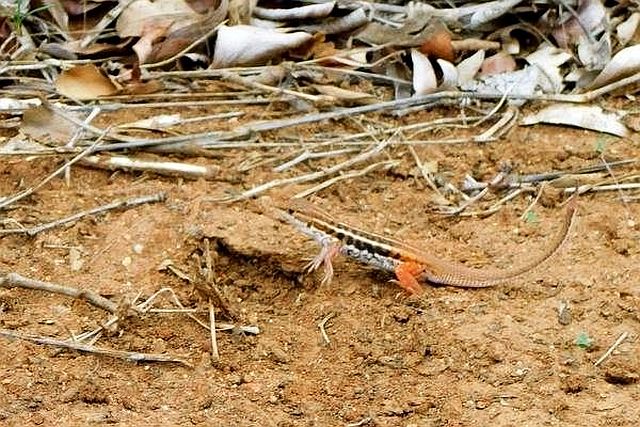 © Klipspringer
© Klipspringer
Juvenile (Shingwedzi)
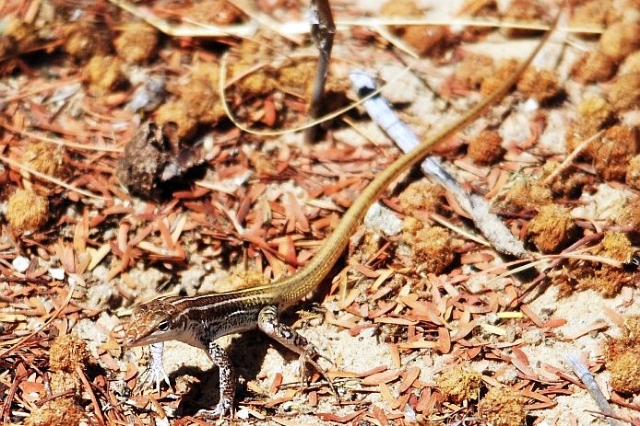 © Mel
© Mel
Kgalagadi Transfrontier Park
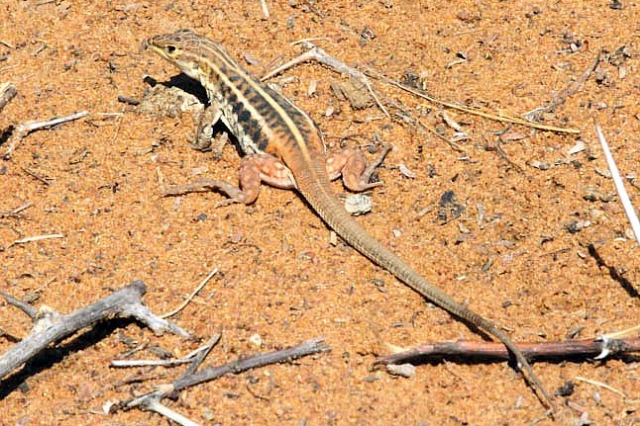 © Super Mongoose
© Super Mongoose
Marakele National Park
Size
16-20 cm; max. 22 cm.
Description
Adult H. lugubris are pale red and buff in color, matching Kalahari sands. Juveniles have pitch black bodies with white spots, and a reddish tail.
Scalation: small elongate temporal borders each parietal. Crescent-shaped tympanic scale above ear opening. Lower eyelids scaly. Subocular borders the lip. Dorsal scales: small and keeled at midbody, 63-71 transverse rows at midbody. Collar: present. Ventral scales: 6 longitudinal rows. Other: 12-18 femoral pores beneath each thigh, 2-3 keels on scales beneath toes.
Coloration: Adults are overall grey- to red-brown with indistinct black transverse bars and three light dorsal longitudinal stripes: the middle one divides on the neck and extends onto the tail. Tail is usually pale brown and there are pale spots on the legs. Ventral surfaces are white.
Hatchlings are jet black, with broken yellow-white dorsal and lateral stripes and a sand-coloured tail: this, and their jerky and stiff way of movement, makes them effective mimics of a local beetle which can squirt pungent acidic fluid at predators, and thus grants them some protection.
Geographic Distribution
From Lowveld and SE Zimbabwe, through Botswana, Northern Cape and central Namibia to southern Angola.
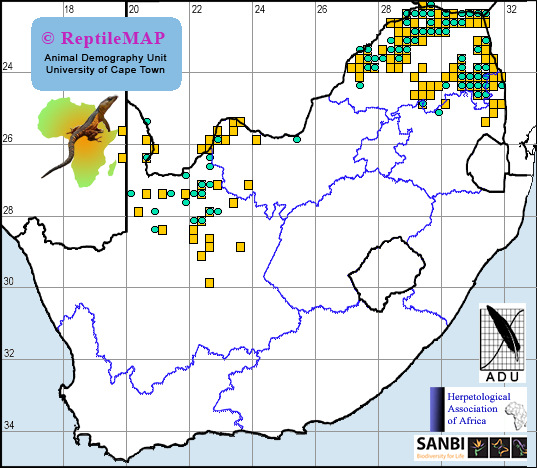
Habitat
Arid and mesic savannah. They are fairly common on sandy, sparsely vegetated plains, where they dart from bush to bush.
Behaviour
In the Kalahari and the Namib desert, juvenile Heliobolus lugubris employ an interesting anti-predator tactic involving deception known as Batesian mimicry . These defenseless small lizards mimic noxious "Oogpister" beetles (Carabidae: Anthia/Thermophilum spp.), which emit pungent acids, aldehydes, and other chemicals when disturbed.
Whereas adults walk with a normal tetrapod lizard gait, with their backs undulating from side to side, juveniles walk stiff-legged, with backs arched vertically holding their reddish tails flat against the ground (this makes the tail difficult to detect). When pursued, young H. lugubris abandon their "beetle walk" and dart rapidly for cover, using normal lizard locomotion. As they reach a size of about 45-50 mm from snout to vent (the size of the largest oogpister beetles), these lizards "metamorphose" into the cryptic adult coloration and permanently abandon the stilt walk. The frequency of broken and regenerated tails is lower in juvenile H. lugubris than among closely related lacertids in the same habitats exposed to common predators, suggesting that this beetle mimicry does reduce predatory attacks
Diet
It is insectivorous and forages widely for its food, with termites being especially favoured.
Reproduction
The female lays 4-6 eggs in a chamber dug in loose sand. Eggs hatch December-May.

Adult © ExFmem

Kgalagadi Transfrontier Park © ExFmem
Family: Lacertidae
Grietjie Private Reserve, Limpopo
Hatchling
Juvenile (Shingwedzi)
 © Mel
© MelKgalagadi Transfrontier Park
 © Super Mongoose
© Super MongooseMarakele National Park
Size
16-20 cm; max. 22 cm.
Description
Adult H. lugubris are pale red and buff in color, matching Kalahari sands. Juveniles have pitch black bodies with white spots, and a reddish tail.
Scalation: small elongate temporal borders each parietal. Crescent-shaped tympanic scale above ear opening. Lower eyelids scaly. Subocular borders the lip. Dorsal scales: small and keeled at midbody, 63-71 transverse rows at midbody. Collar: present. Ventral scales: 6 longitudinal rows. Other: 12-18 femoral pores beneath each thigh, 2-3 keels on scales beneath toes.
Coloration: Adults are overall grey- to red-brown with indistinct black transverse bars and three light dorsal longitudinal stripes: the middle one divides on the neck and extends onto the tail. Tail is usually pale brown and there are pale spots on the legs. Ventral surfaces are white.
Hatchlings are jet black, with broken yellow-white dorsal and lateral stripes and a sand-coloured tail: this, and their jerky and stiff way of movement, makes them effective mimics of a local beetle which can squirt pungent acidic fluid at predators, and thus grants them some protection.
Geographic Distribution
From Lowveld and SE Zimbabwe, through Botswana, Northern Cape and central Namibia to southern Angola.
Habitat
Arid and mesic savannah. They are fairly common on sandy, sparsely vegetated plains, where they dart from bush to bush.
Behaviour
In the Kalahari and the Namib desert, juvenile Heliobolus lugubris employ an interesting anti-predator tactic involving deception known as Batesian mimicry . These defenseless small lizards mimic noxious "Oogpister" beetles (Carabidae: Anthia/Thermophilum spp.), which emit pungent acids, aldehydes, and other chemicals when disturbed.
Whereas adults walk with a normal tetrapod lizard gait, with their backs undulating from side to side, juveniles walk stiff-legged, with backs arched vertically holding their reddish tails flat against the ground (this makes the tail difficult to detect). When pursued, young H. lugubris abandon their "beetle walk" and dart rapidly for cover, using normal lizard locomotion. As they reach a size of about 45-50 mm from snout to vent (the size of the largest oogpister beetles), these lizards "metamorphose" into the cryptic adult coloration and permanently abandon the stilt walk. The frequency of broken and regenerated tails is lower in juvenile H. lugubris than among closely related lacertids in the same habitats exposed to common predators, suggesting that this beetle mimicry does reduce predatory attacks
Diet
It is insectivorous and forages widely for its food, with termites being especially favoured.
Reproduction
The female lays 4-6 eggs in a chamber dug in loose sand. Eggs hatch December-May.

Adult © ExFmem

Kgalagadi Transfrontier Park © ExFmem
Re: Africa Wild Reptile Book: Lizards - Photos & Description
Wedge-snouted Desert Lizard Meroles cuneirostris (Wigneus Woestynakkedis)
Family: Lacertidae
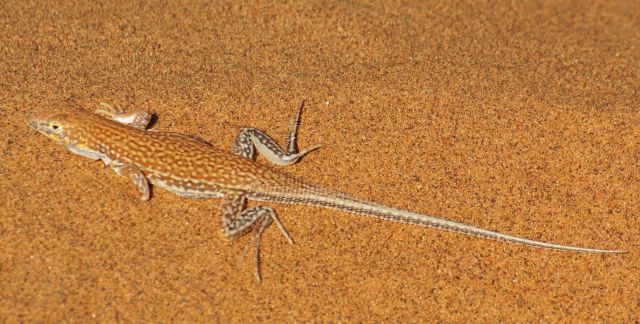 © Kesheshe
© Kesheshe
 © Kesheshe
© Kesheshe
Namib
Size
The lizard is 13-15 cm from the snout to the end of the tail and weighs fully grown 7 to 10 g.
Description
Desert Lizards have fine, granular dorsal scales. The hind toes are elongated and possess fringes of scales. It is a fast mover.
Distinguishable by flattened wedge-shaped snout and conspicuous serrated fringe on toes.
Scalation details: supranasals not in contact; nasals swollen; 90-110 scales rows at midbody; 24-30 ventral rows; 18-24 femoral pores on each thigh; ear opening covered with fold of skin. 3 supraoculars present. Rostral in contact with frontonasal. 90 - 110 scales across middle of dorsum,
Coloration: overall, matches sand colour; dorsally greyish, sand-coloured or reddish-brown with pale spots (these may be absent) and dark flecks. The male dorsal pattern is more reticulated. Pale dorsolateral stripe runs from eye to tail. Lateral skin folds and upper lip may be orange. Belly is white.
Geographic Distribution
SW Namibia (Richtersveld to Walvis Bay). It is one of the endemic species of the Southern Namib Desert.
Habitat
M. cuneirostris lives in sparsely vegetated desert and coastal dunes.
Behaviour
The lizard lives in vegetated dunes, and when frightened they run into bushes or dive into soft dune sand. Wedge-snouted lizard feed during the day, usually during the coolest time of the day. Wedge-snouted lizards are known to use their pointed snout to dive into the sand and escape enemies and hot conditions. They are thought to feed on termites and other small insects and get water from their food.
Diet
Diet varies seasonally, mainly adult beetles in the summer and termites and other small insects in the winter. They hunt mainly in the cooler morning and evening. Branch notes an interesting aspect of their behaviour is waiting next to ant paths and robbing passing ants of their own insect prey.
Reproduction
Apparently no distinct breeding season. 2-4 eggs laid in soft sand up to 60 cm below the surface.
Links: William R. Branch: Field Guide to Snakes and Other Reptiles of Southern Africa
Family: Lacertidae
 © Kesheshe
© Kesheshe © Kesheshe
© KeshesheNamib
Size
The lizard is 13-15 cm from the snout to the end of the tail and weighs fully grown 7 to 10 g.
Description
Desert Lizards have fine, granular dorsal scales. The hind toes are elongated and possess fringes of scales. It is a fast mover.
Distinguishable by flattened wedge-shaped snout and conspicuous serrated fringe on toes.
Scalation details: supranasals not in contact; nasals swollen; 90-110 scales rows at midbody; 24-30 ventral rows; 18-24 femoral pores on each thigh; ear opening covered with fold of skin. 3 supraoculars present. Rostral in contact with frontonasal. 90 - 110 scales across middle of dorsum,
Coloration: overall, matches sand colour; dorsally greyish, sand-coloured or reddish-brown with pale spots (these may be absent) and dark flecks. The male dorsal pattern is more reticulated. Pale dorsolateral stripe runs from eye to tail. Lateral skin folds and upper lip may be orange. Belly is white.
Geographic Distribution
SW Namibia (Richtersveld to Walvis Bay). It is one of the endemic species of the Southern Namib Desert.
Habitat
M. cuneirostris lives in sparsely vegetated desert and coastal dunes.
Behaviour
The lizard lives in vegetated dunes, and when frightened they run into bushes or dive into soft dune sand. Wedge-snouted lizard feed during the day, usually during the coolest time of the day. Wedge-snouted lizards are known to use their pointed snout to dive into the sand and escape enemies and hot conditions. They are thought to feed on termites and other small insects and get water from their food.
Diet
Diet varies seasonally, mainly adult beetles in the summer and termites and other small insects in the winter. They hunt mainly in the cooler morning and evening. Branch notes an interesting aspect of their behaviour is waiting next to ant paths and robbing passing ants of their own insect prey.
Reproduction
Apparently no distinct breeding season. 2-4 eggs laid in soft sand up to 60 cm below the surface.
Links: William R. Branch: Field Guide to Snakes and Other Reptiles of Southern Africa
- Mel
- Global Moderator
- Posts: 27436
- Joined: Sat May 19, 2012 12:31 pm
- Country: Germany
- Location: Föhr
- Contact:
Africa Wild Reptile Book: Lizards - Photos & Descriptions
Western Sandveld Lizard (Striped Sandveld Lizard) Nucras tessellata (Westelike Sandveldakkedis)
Family: Lacertidae
 © ExFmem
© ExFmem
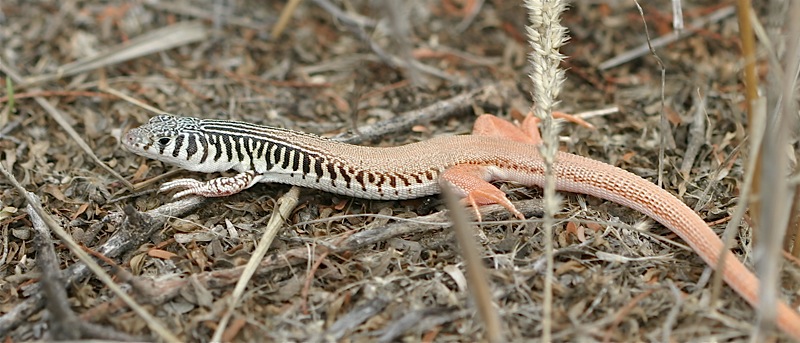 © ExFmem
© ExFmem
Size
A relatively large lacertid, adults got a snout to vent length of between 70 and 92 mm. The total length is up to 250 mm with the tail making up two third of the whole body.
Description
The Western Sandveld Lizard is a slender, rather brightly and beautifully coloured lizard with a long tail which accounts for about two-thirds its length and is used as a rudder during its lightning dashes. It has 5-7 enlarged plates under each forearm, 36-48 scale rows at mid body, and 11-18 femoral pores on each thigh.
The dorsally black body has 4 thin cream stripes on the back and brilliant white bars on the flanks (similar to the barring in a zebra). The rear of the body, tail and hind limbs are all a deep reddish-brown. Some species are pale red-buff and have only two light stripes on the back.The belly is pure white.In breeding colors, it is strongly striped in black and white over its forequarters, becoming bright orange-brown over its hindquarters and tail - its non-breeding colors show striping down the entire length of the body. Juveniles in the Kalahari have pale blue forebordies.
The limbs are well developed and it sports the long tail typical of lacertids.
Geographical distribution
This lizard is restricted to the western parts of South Africa and can be found in the Western Cape, the western Little Karoo, Twanka Karoo, Namaqualand, Richterveld, Kgalagadi and in southern Namibia and in southwestern Botswana.
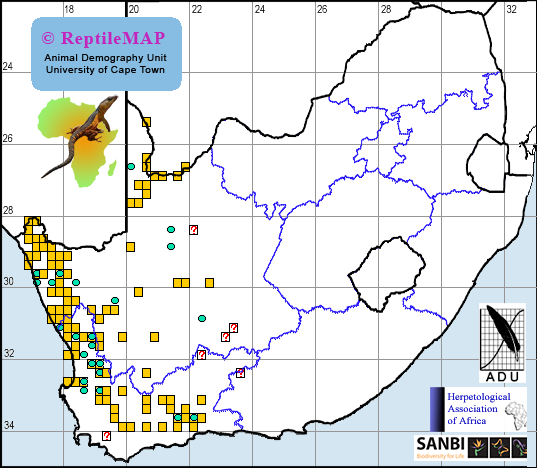
Habitat
Rocky ground in arid savannah and karroid veld. Although preferring arid, sandy areas they also stray into fynbos and mountain grassland.
Behaviour
The Western Sandveld Lizard is a terrestrial species. It will dig a hole for a retreat at the base of bushes or underneath rocks or any kind of debris. It is a diurnal species and an active forager. Nevertheless, it is not often seen (I was extremely lucky here as even the knowledgable ranger hadn't seen this kind of lizard before) and doesn’t occur in great numbers. It is active in the early mornings and late afternoon when it forages for any kind of invertebrate prey. The very long tail remains a bit of a mystery. It is thought that it is meant to increase the chances that a predator will catch the tail rather than the body (which is true for the photos above – note the tail underneath / behind the plated lizard in photos no. 2 and 3), enabling the lizard a chance to escape (which is unfortunately not true for the photos below as the skink killed it). The zebra stripes on the sides of the body may confuse the predator even further. Probably because of its long tail, it is not as agile as most other lacertids.
Diet
Digs out scorpions and spiders. Also feeds on grasshoppers, termites, beetles and cockroaches.
Predators
Their main predators are birds of prey and snakes and obviously skinks.
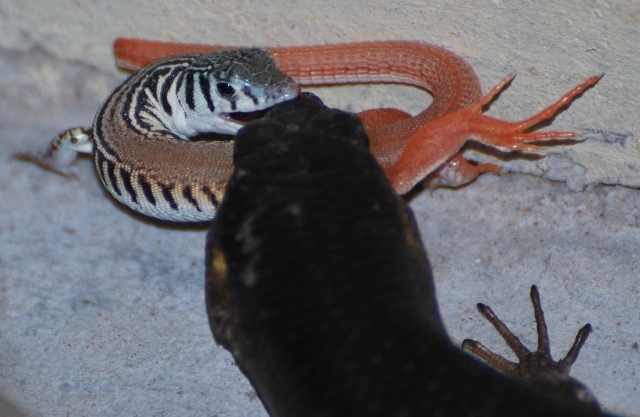
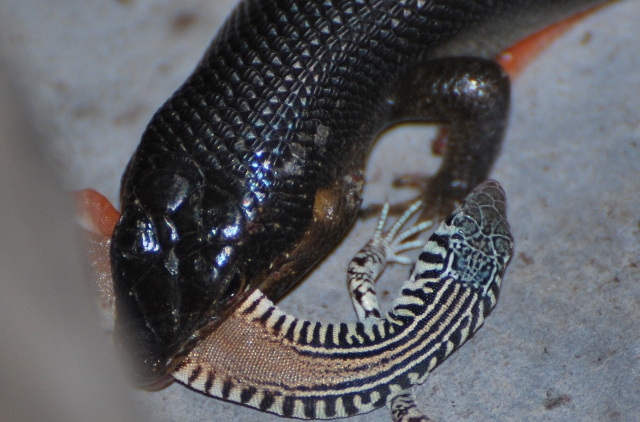

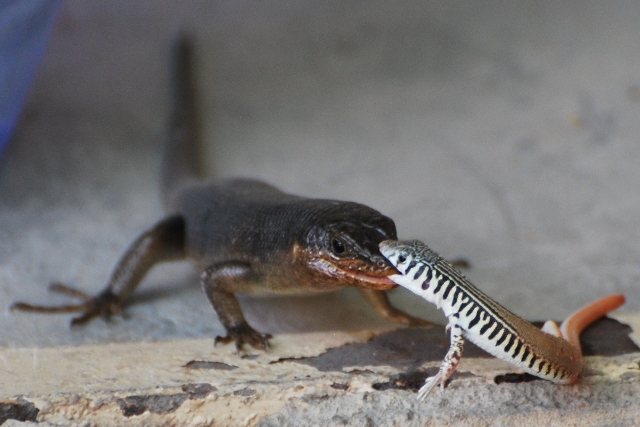
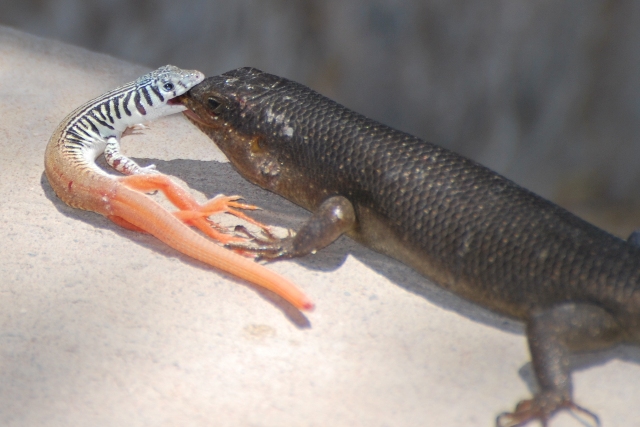
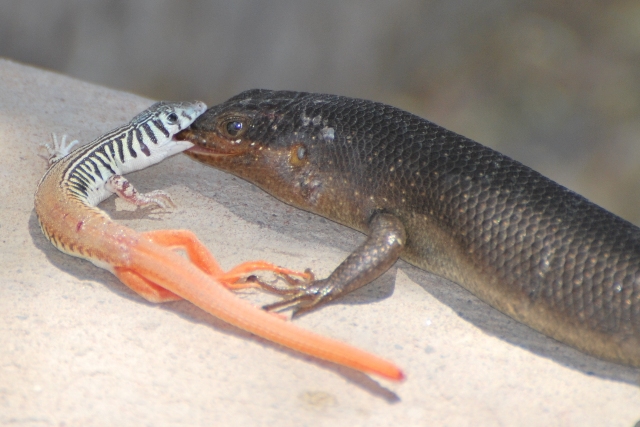
All photos in KTP.
Reproduction
Like most lacertids, the Western Sandveld Lizard is oviparous and the females lay 3 to 4 eggs in early summer.
Family: Lacertidae
 © ExFmem
© ExFmem © ExFmem
© ExFmemSize
A relatively large lacertid, adults got a snout to vent length of between 70 and 92 mm. The total length is up to 250 mm with the tail making up two third of the whole body.
Description
The Western Sandveld Lizard is a slender, rather brightly and beautifully coloured lizard with a long tail which accounts for about two-thirds its length and is used as a rudder during its lightning dashes. It has 5-7 enlarged plates under each forearm, 36-48 scale rows at mid body, and 11-18 femoral pores on each thigh.
The dorsally black body has 4 thin cream stripes on the back and brilliant white bars on the flanks (similar to the barring in a zebra). The rear of the body, tail and hind limbs are all a deep reddish-brown. Some species are pale red-buff and have only two light stripes on the back.The belly is pure white.In breeding colors, it is strongly striped in black and white over its forequarters, becoming bright orange-brown over its hindquarters and tail - its non-breeding colors show striping down the entire length of the body. Juveniles in the Kalahari have pale blue forebordies.
The limbs are well developed and it sports the long tail typical of lacertids.
Geographical distribution
This lizard is restricted to the western parts of South Africa and can be found in the Western Cape, the western Little Karoo, Twanka Karoo, Namaqualand, Richterveld, Kgalagadi and in southern Namibia and in southwestern Botswana.
Habitat
Rocky ground in arid savannah and karroid veld. Although preferring arid, sandy areas they also stray into fynbos and mountain grassland.
Behaviour
The Western Sandveld Lizard is a terrestrial species. It will dig a hole for a retreat at the base of bushes or underneath rocks or any kind of debris. It is a diurnal species and an active forager. Nevertheless, it is not often seen (I was extremely lucky here as even the knowledgable ranger hadn't seen this kind of lizard before) and doesn’t occur in great numbers. It is active in the early mornings and late afternoon when it forages for any kind of invertebrate prey. The very long tail remains a bit of a mystery. It is thought that it is meant to increase the chances that a predator will catch the tail rather than the body (which is true for the photos above – note the tail underneath / behind the plated lizard in photos no. 2 and 3), enabling the lizard a chance to escape (which is unfortunately not true for the photos below as the skink killed it). The zebra stripes on the sides of the body may confuse the predator even further. Probably because of its long tail, it is not as agile as most other lacertids.
Diet
Digs out scorpions and spiders. Also feeds on grasshoppers, termites, beetles and cockroaches.
Predators
Their main predators are birds of prey and snakes and obviously skinks.






All photos in KTP.
Reproduction
Like most lacertids, the Western Sandveld Lizard is oviparous and the females lay 3 to 4 eggs in early summer.
God put me on earth to accomplish a certain amount of things. Right now I'm so far behind that I'll never die.
- nan
- Posts: 26471
- Joined: Thu May 31, 2012 9:41 pm
- Country: Switzerland
- Location: Central Europe
- Contact:
Re: Lizards - Pics & Descriptions
Spotted Sand Lizard Pedioplanis lineoocelata lineoocelata (Gevlekte Sandakkedis)
Family: Lacertidae
 Kgalagadi
Kgalagadi

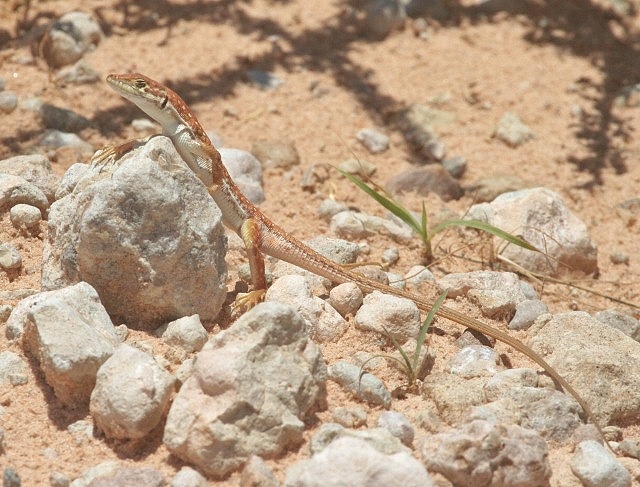
Size
12-17 cm. SVL 45 to 55mm. Max SVL 58mm.
DescriptionIt has a slightly flattened head and body, ideal to move around the flat rocky veld. Body slender. Long tail. Distinct collar, faint fold under throat. Black lined clear "window" in lower eyelid.
The tail of the spotted sand lizard is not as long as that of other lacertids, but the lizard has the typical lacertid built, namely a elongated, slender body with well-developed legs and long toes. It has 10-17 femoral pores on each thigh. Coloration is extremely variable.
The colour of the back may range from grey-brown to red-brown, usually with 2-4 rows of small, pale dorsal spots that may fuse into broken or continuous dorsolateral stripes. The flanks have a series of large, pale-blue spots that may be dark-edged. Namaqualand specimens usually have paired black dorsolateral stripes. The hindlegs are usually spotted and the tail is flecked with pale and dark dots. Sometimes, individuals may be fairly uniformly coloured. The belly is white. Adult males sometimes have a blue-grey throat.
Namibian species are more brightly coloured than other southern African spotted sand lizards. Juveniles striped. Adults have series of pale blue spots on flanks.
Geographic Distribution
The spotted sand lizard has an extensive range in the western half of southern Africa reaching well into Namibia and Botswana.
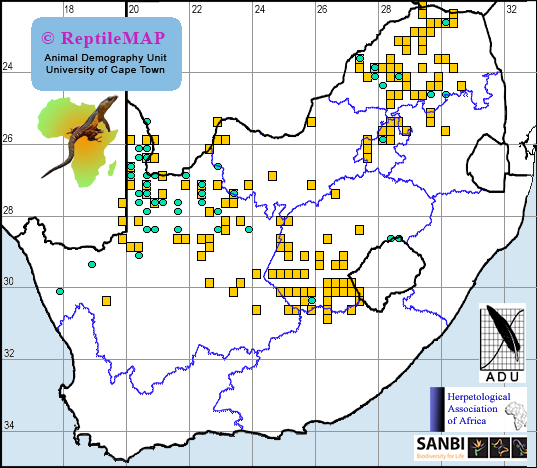
Habitat
Arid savannah with rocky flats, broken ground.
Behaviour
Active during the day, even in the colder winter periods, sheltering in small burrows dug beneath a flat rock.
Diet
These lizards will sit and wait for their prey to parade in front of them before they grab small insects after a short, swift run from cover. They are seasonal feeders on termites during winter and beetles and locusts in the summer.
Reproduction
Females lay between 4 to 8 eggs in early summer (November) after digging a suitable chamber in moist soil beneath a rock for shade and protection. Eggs hatch in February. Hatchlings measure 50-55 mm in total length.
Links: SANBI
Family: Lacertidae
 Kgalagadi
Kgalagadi

Size
12-17 cm. SVL 45 to 55mm. Max SVL 58mm.
DescriptionIt has a slightly flattened head and body, ideal to move around the flat rocky veld. Body slender. Long tail. Distinct collar, faint fold under throat. Black lined clear "window" in lower eyelid.
The tail of the spotted sand lizard is not as long as that of other lacertids, but the lizard has the typical lacertid built, namely a elongated, slender body with well-developed legs and long toes. It has 10-17 femoral pores on each thigh. Coloration is extremely variable.
The colour of the back may range from grey-brown to red-brown, usually with 2-4 rows of small, pale dorsal spots that may fuse into broken or continuous dorsolateral stripes. The flanks have a series of large, pale-blue spots that may be dark-edged. Namaqualand specimens usually have paired black dorsolateral stripes. The hindlegs are usually spotted and the tail is flecked with pale and dark dots. Sometimes, individuals may be fairly uniformly coloured. The belly is white. Adult males sometimes have a blue-grey throat.
Namibian species are more brightly coloured than other southern African spotted sand lizards. Juveniles striped. Adults have series of pale blue spots on flanks.
Geographic Distribution
The spotted sand lizard has an extensive range in the western half of southern Africa reaching well into Namibia and Botswana.
Habitat
Arid savannah with rocky flats, broken ground.
Behaviour
Active during the day, even in the colder winter periods, sheltering in small burrows dug beneath a flat rock.
Diet
These lizards will sit and wait for their prey to parade in front of them before they grab small insects after a short, swift run from cover. They are seasonal feeders on termites during winter and beetles and locusts in the summer.
Reproduction
Females lay between 4 to 8 eggs in early summer (November) after digging a suitable chamber in moist soil beneath a rock for shade and protection. Eggs hatch in February. Hatchlings measure 50-55 mm in total length.
Links: SANBI
Kgalagadi lover… for ever
https://safrounet.piwigo.com/
https://safrounet.piwigo.com/
Re: AW Reptile Book: Lizards - Pics & Descriptions
Namaqua Sand Lizard Pedioplanis namaquensis
Family: Lacertidae
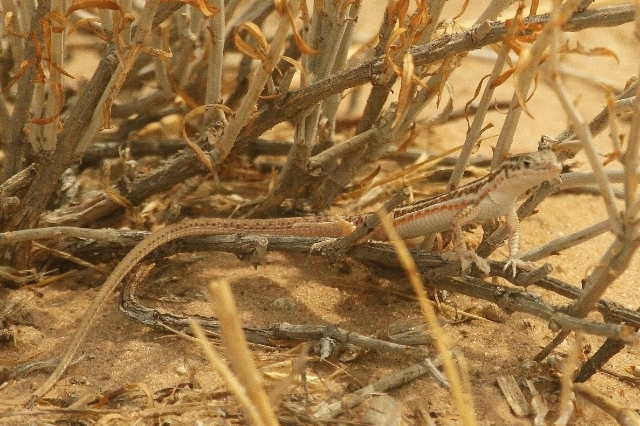 © nan
© nan
Kgalagadi Transfrontier Park
Size
SVL 42–56 mm.
Description
Body slender. Long tail. Granular scales. Distinct collar, faint fold under the throat. Cryptically coloured in tans and browns with pale stripes.
Juvenile: vividly striped, pink-brown tail.
Geographic Distribution
It is found in the Eastern Cape Province of South Africa, through the Karoo, Namaqualand, Namibia and Botswana to southern Angola.
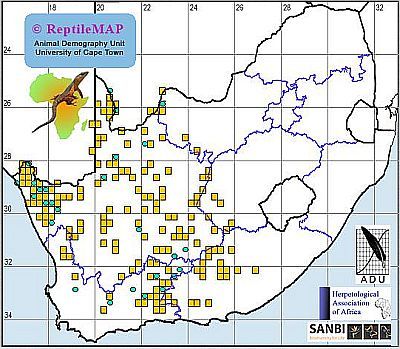
Habitat
It inhabits karroid veld, arid savanna and semi-desert.
Behaviour
Diurnal. Pedioplanis namaquensis is largely inactive during winter months. It forages widley for food.
Reproduction
3–5 eggs are laid in November.
Family: Lacertidae
 © nan
© nanKgalagadi Transfrontier Park
Size
SVL 42–56 mm.
Description
Body slender. Long tail. Granular scales. Distinct collar, faint fold under the throat. Cryptically coloured in tans and browns with pale stripes.
Juvenile: vividly striped, pink-brown tail.
Geographic Distribution
It is found in the Eastern Cape Province of South Africa, through the Karoo, Namaqualand, Namibia and Botswana to southern Angola.

Habitat
It inhabits karroid veld, arid savanna and semi-desert.
Behaviour
Diurnal. Pedioplanis namaquensis is largely inactive during winter months. It forages widley for food.
Reproduction
3–5 eggs are laid in November.
Family Scincidae
Skinks (Scincidae)
Skinks look roughly like true lizards, but most species have no pronounced neck and their legs are relatively small; several genera (e.g., Typhlosaurus) have no limbs at all. Other genera, such as Neoseps, have reduced limbs, lacking forelegs, and with fewer than five toes (digits) on each foot. In such species, their locomotion resembles that of snakes more than that of lizards with well-developed limbs. As a general rule, the longer the digits, the more arboreal the species is likely to be. A biological ratio can determine the ecological niche of a given skink species. The Scincidae ecological niche index is a ratio based on anterior foot length at the junction of the ulna/radius-carpal bones to the longest digit divided by the snout-to-vent length.
Most species of skinks have long, tapering tails they can shed if predators grab onto them. Such species generally can regenerate the lost part of a tail, though imperfectly. Species with stumpy tails have no special regenerative abilities.
The dorsal scales are usually smooth, flat and highly polished, often appearing iridescent.
These lizards are usually terrestrial, although many may live in trees and among rocks. They are all diurnal. Most of them are of medium size. Many of the species that forage among leaf litter have elongated bodies and reduced limbs and some burrowing forms are completely limbless.
47 species occur in South Africa, making it the second largest family in the country.
Skinks look roughly like true lizards, but most species have no pronounced neck and their legs are relatively small; several genera (e.g., Typhlosaurus) have no limbs at all. Other genera, such as Neoseps, have reduced limbs, lacking forelegs, and with fewer than five toes (digits) on each foot. In such species, their locomotion resembles that of snakes more than that of lizards with well-developed limbs. As a general rule, the longer the digits, the more arboreal the species is likely to be. A biological ratio can determine the ecological niche of a given skink species. The Scincidae ecological niche index is a ratio based on anterior foot length at the junction of the ulna/radius-carpal bones to the longest digit divided by the snout-to-vent length.
Most species of skinks have long, tapering tails they can shed if predators grab onto them. Such species generally can regenerate the lost part of a tail, though imperfectly. Species with stumpy tails have no special regenerative abilities.
The dorsal scales are usually smooth, flat and highly polished, often appearing iridescent.
These lizards are usually terrestrial, although many may live in trees and among rocks. They are all diurnal. Most of them are of medium size. Many of the species that forage among leaf litter have elongated bodies and reduced limbs and some burrowing forms are completely limbless.
47 species occur in South Africa, making it the second largest family in the country.
Subfamily Acontinae
The African subfamily Acontinae contains limbless skinks. Most are small animals, but the largest member of the genus is Acontias plumbeus at approximately 40 cm snout-vent length. All members of this genus are live-bearing, sandswimmers, with fused eyelids.
A recent review moved species that were formerly placed in the genera Typhlosaurus, Acontophiops, and Microacontias into this genus, as together these form a single branch in the tree of life. This new concept of Acontias is a sister lineage to Typhlosaurus, and these two genera are the only genera within the subfamily Acontinae.
A recent review moved species that were formerly placed in the genera Typhlosaurus, Acontophiops, and Microacontias into this genus, as together these form a single branch in the tree of life. This new concept of Acontias is a sister lineage to Typhlosaurus, and these two genera are the only genera within the subfamily Acontinae.
Re: Africa Wild Reptile Book: Lizards - Photos & Description
Giant Legless Skink Acontias plumbeus (Reuse pootlose skink)
Family: Scincidae
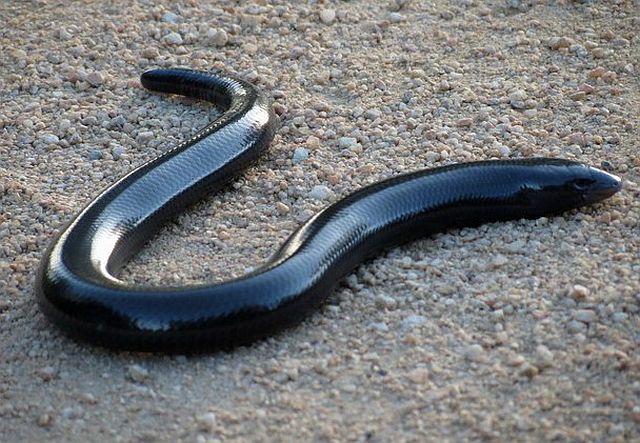 © Bushcraft
© Bushcraft
Kruger National Park
 © Bushcraft
© Bushcraft
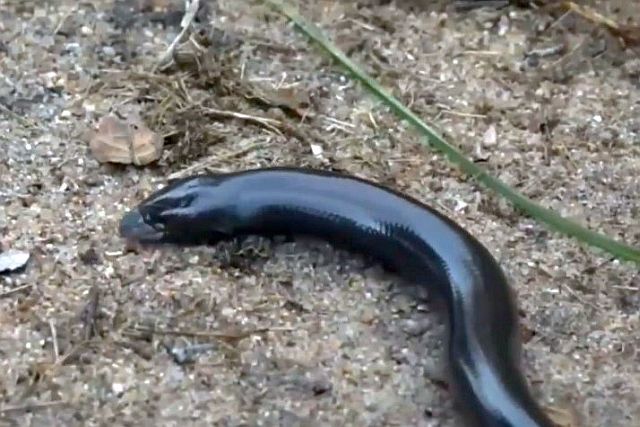 © Klipspringer
© Klipspringer
Description
This is the largest of the legless skinks with about 40 cm in length (max. SVL about 490 mm). This skink has a powerful body extremely thick around the middle with a short cylindrical tail, but it has no limbs and moves with serpentine undulations along the ground. The broad head has an elongate, steel-grey snout. Like other members of the genus, it retains eyelids. It is uniform shiny black to dark brown and has smooth overlapping scales.
Geographical distribution
This species is found in South Africa from the northeastern Limpopo province, extending through Mpumalanga to coastal northern KwaZulu-Natal and the Eastern Cape. It is also found in Swaziland, southern Mozambique and there is an isolated relict population that occurs on the eastern escarpment of Zimbabwe.
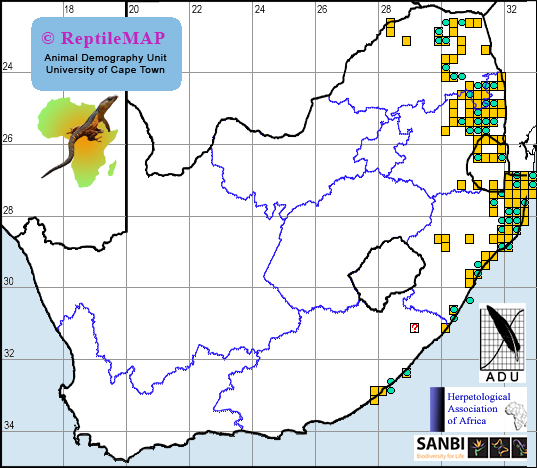
Habitat
These lizards occur in forested and bushveld regions or coastal forest containing loose soil into which they burrow.
Behaviour
It burrows in moist leaf litter. After heavy rains they are driven out of the soil and emerge from the underground retreat.
When threatened, as a defence mechanism, these harmless skinks are thought to mimic the venomous Southern Stiletto Snake.
Diet
The Giant Legless Skink's diet comprises insects and other invertebrates such as earthworms or insect larvae which occur in compost-like situations. It will even take burrowing frogs and nestling rodents.
Reproduction
Viviparous, 2-14 young are born in late summer.
Family: Scincidae
 © Bushcraft
© BushcraftKruger National Park
 © Bushcraft
© BushcraftDescription
This is the largest of the legless skinks with about 40 cm in length (max. SVL about 490 mm). This skink has a powerful body extremely thick around the middle with a short cylindrical tail, but it has no limbs and moves with serpentine undulations along the ground. The broad head has an elongate, steel-grey snout. Like other members of the genus, it retains eyelids. It is uniform shiny black to dark brown and has smooth overlapping scales.
Geographical distribution
This species is found in South Africa from the northeastern Limpopo province, extending through Mpumalanga to coastal northern KwaZulu-Natal and the Eastern Cape. It is also found in Swaziland, southern Mozambique and there is an isolated relict population that occurs on the eastern escarpment of Zimbabwe.
Habitat
These lizards occur in forested and bushveld regions or coastal forest containing loose soil into which they burrow.
Behaviour
It burrows in moist leaf litter. After heavy rains they are driven out of the soil and emerge from the underground retreat.
When threatened, as a defence mechanism, these harmless skinks are thought to mimic the venomous Southern Stiletto Snake.
Diet
The Giant Legless Skink's diet comprises insects and other invertebrates such as earthworms or insect larvae which occur in compost-like situations. It will even take burrowing frogs and nestling rodents.
Reproduction
Viviparous, 2-14 young are born in late summer.
Subfamily Lygosominae
Lygosominae is the largest subfamily of skinks in the family Scincidae. The subfamily can be divided into a number of genus groups.
Trachylepis is a skink genus in this subfamily found mainly in Africa. Its members were formerly included in the "wastebin taxon" Mabuya. As defined today, Trachylepis contains the clade of Afro-Malagasy mabuyas.
Trachylepis is a skink genus in this subfamily found mainly in Africa. Its members were formerly included in the "wastebin taxon" Mabuya. As defined today, Trachylepis contains the clade of Afro-Malagasy mabuyas.


